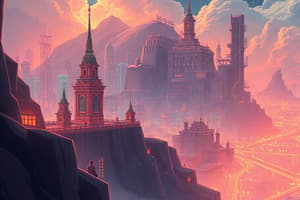Podcast
Questions and Answers
What is the primary driver of the transactions that make up the economy?
What is the primary driver of the transactions that make up the economy?
- Technological advancements
- Human nature (correct)
- Market trends
- Government policies
What is the outcome of combining the total spending and total quantity sold in all markets?
What is the outcome of combining the total spending and total quantity sold in all markets?
- A comprehensive picture of the economy's movements (correct)
- A complete breakdown of the economy's components
- A forecast of future economic trends
- A detailed understanding of the economy's complexities
How many main forces drive the economy, according to the author's template?
How many main forces drive the economy, according to the author's template?
- 5
- 3 (correct)
- 4
- 2
What is exchanged in a transaction, according to the author?
What is exchanged in a transaction, according to the author?
What is the author's approach to understanding the economy?
What is the author's approach to understanding the economy?
What is the primary reason why credit is considered the most important part of the economy?
What is the primary reason why credit is considered the most important part of the economy?
What happens to the asset and liability when a borrower repays a loan, plus interest?
What happens to the asset and liability when a borrower repays a loan, plus interest?
Why do lenders feel comfortable lending money to borrowers with valuable assets?
Why do lenders feel comfortable lending money to borrowers with valuable assets?
What is the main driver of economic growth according to the passage?
What is the main driver of economic growth according to the passage?
What is the duration of the two big debt cycles mentioned in the passage?
What is the duration of the two big debt cycles mentioned in the passage?
Flashcards are hidden until you start studying
Study Notes
Understanding the Economy
- The economy works like a simple machine with a few simple parts and repetitive transactions driven by human nature.
- Three main forces drive the economy: Productivity growth, Short-term debt cycle, and Long-term debt cycle.
Transactions and Credit
- An economy is the sum of transactions, and a transaction consists of a buyer exchanging money or credit with a seller for goods, services, or financial assets.
- Credit spends like money, and understanding credit is crucial as it's the most important and volatile part of the economy.
- Credit is created when lenders and borrowers engage in transactions, and it immediately turns into debt, becoming an asset to the lender and a liability to the borrower.
Importance of Credit
- Credit allows borrowers to increase spending, which drives the economy, as increased income leads to increased borrowing, and subsequently, increased spending.
- Credit enables consumption beyond production, and debt repayment forces consumption below production, leading to economic swings.
Debt Cycles
- Debt swings occur in two significant cycles: a short-term cycle lasting 5 to 8 years and a long-term cycle lasting 75 to 100 years.
- These cycles are often overlooked due to their frequency and proximity, but understanding them is essential for tracking economic movements.
Studying That Suits You
Use AI to generate personalized quizzes and flashcards to suit your learning preferences.




